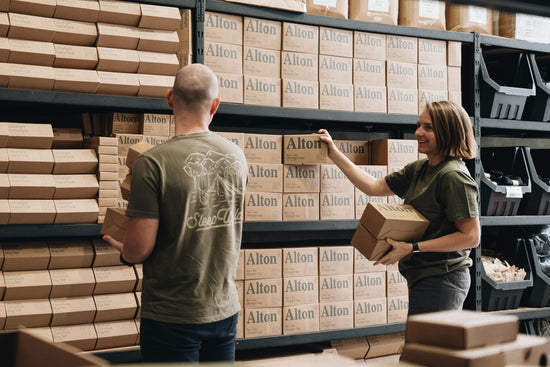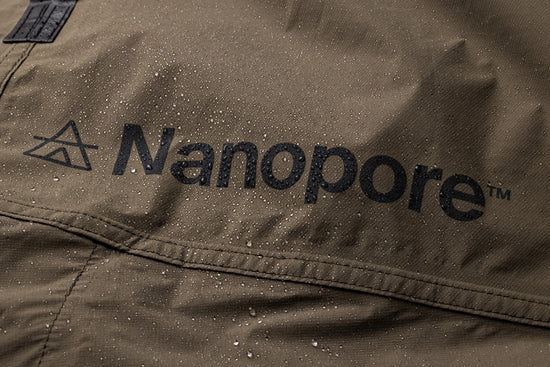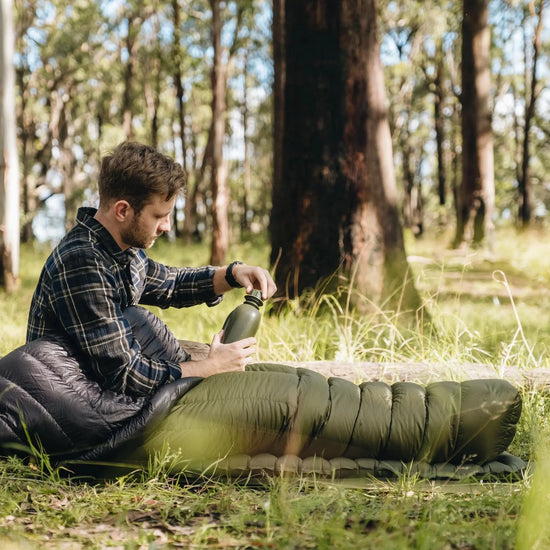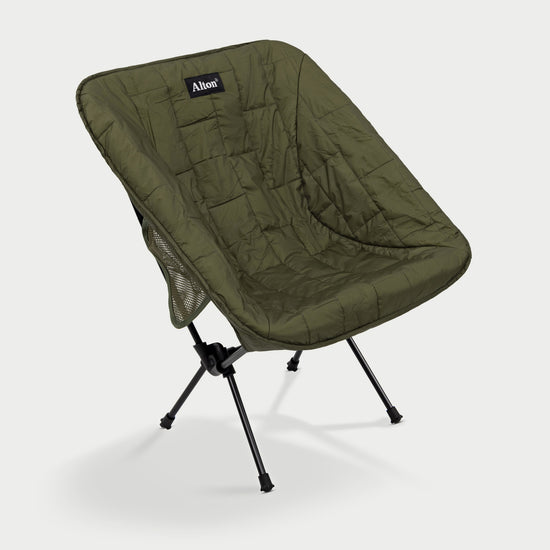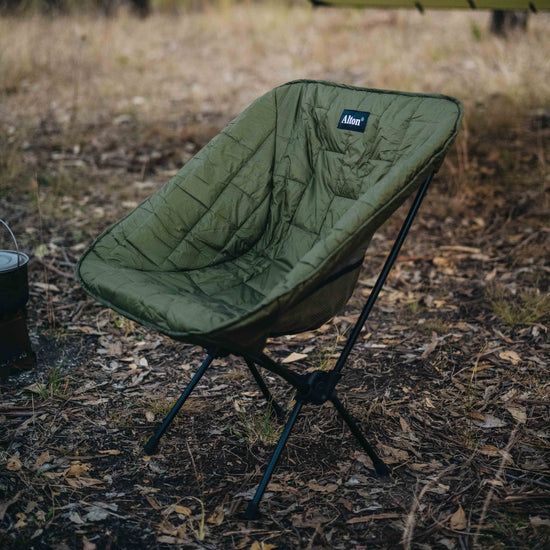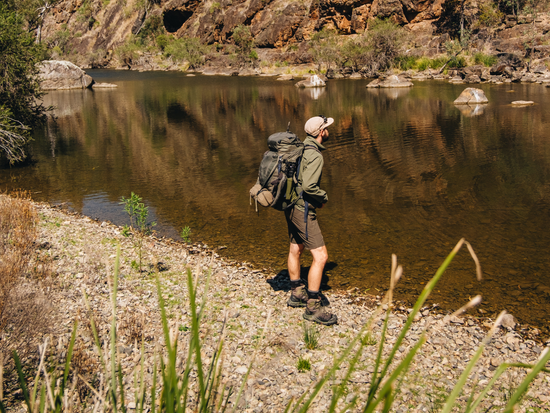When shopping for a new sleeping bag, the first question most people ask is something along the lines of, “what is better, down or synthetic?”.
The short answer is that it all depends how and where you’ll be using it… but we will say down sleeping bags have a lot going for them.
And the long answer? Well, since you asked… We've written an entire blog about it!
Yep, today’s article is our in-depth guide to what is the best insulation for a sleeping bag, down or synthetic.
We’ll compare both options to see how they stack up when it comes to important factors like warmth-to-weight ratio, packability, water-resistance, care and maintenance requirements, longevity, price, and environmental and ethical impact.

What is down and synthetic insulation?
Let’s start with a little run down of what down and synthetic sleeping bags are made from, and how they provide insulation.
Down Sleeping Bag Insulation
Down is made from the soft, wispy plumage found underneath the exterior feathers of waterfowl, such as geese and ducks. These clusters are technically not feathers, but fluffy filaments called ‘plumules’.
These plumules have a unique structure that expands to trap air, making them an incredibly light yet powerful insulator that can be compressed down to a fraction of the size.
The more the plumules can expand to hold air, the greater the insulative capacity they have. This is where terms like ‘loft’ and ‘fill power’ come in. These two terms are often used interchangeably, but fill power is technically the standardised measurement of down loft.
Fill power (FP) is calculated by determining how many cubic inches of space one ounce of down occupies. The more space the plumules occupy, the greater the fill power they have.
In practice, this means that the higher the fill power of a sleeping bag, the better warmth-to-weight ratio it will have.
For example, imagine you want to buy a down sleeping bag rated for 0ºC. A down sleeping bag with 600 FP will require more down (making it heavier and bulkier) to achieve the same result compared to a sleeping bag with 700 FP. And likewise, a sleeping bag with 900 FP would require less down than the one with 700 FP… You get the idea!
Synthetic Sleeping Bag Insulation
Synthetic insulation is typically made from polyester that is processed to form very fine fibres that trap air to create a thermal barrier, just like down.
Although there isn’t a standardised measurement like fill power that determines how effective the synthetic insulation will be, the same idea applies; the more the fibres loft, the more air gets trapped, and the warmer and lighter the sleeping bag will be.
The specific methods used to create synthetic insulation used in sleeping bags varies widely. Modern advancements in synthetic insulation include using hollow-core fibres, adding silicone treatments, and developing special patterning techniques to increase loft. All of this has helped make synthetic sleeping bags much lighter and more compact than they used to be.
Because there is no universal standard of synthetic insulation, it is important to do your research on the specific synthetic sleeping bag you’re considering before you make a purchase.

What's the best insulation for a sleeping bag?
As we always say, there is no such thing as ‘the best’ when it comes to hiking gear. It’s all about what meets specific needs, so let’s take a look at how down and synthetic materials compare across a range of important factors.
As we go through these, keep in mind what, where and how you’ll be using your future sleeping bag.
Warmth-to-Weight Ratio
As we’ve already mentioned, one of the biggest advantages of down is that it is incredibly warm and lightweight.
A synthetic sleeping bag can provide just as much warmth as a down sleeping bag of the same temperature rating, but it will weigh significantly more. We’re talking a few hundred grams, give or take.
You might be thinking, “A few hundred grams? That’s nothing!”
And yes, if your outdoor activity of choice doesn’t require you to physically carry your gear any considerable distance, then maybe that difference in weight isn’t really worth worrying about.
But for adventurers who are pushing their performance across challenging activities like hiking, biking and pack-rafting trips, then a few hundred grams is a big deal.
And maybe even a deal breaker.

Packability
Packability, or how small and compact a sleeping bag can be packed down to, is a very important factor to consider for anyone who is going to be physically carrying their gear for any significant distance.
So which sleeping bag is better for packability, down or synthetic?
Once again, down has the edge here.
Synthetic sleeping bag insulation technology has come a long way in recent years, but it still can’t beat down when it comes to packability.
Due to the natural lofting capabilities of down, a down sleeping bag can be compressed to a fraction of the size.
That means a down sleeping bag can be packed down smaller than a synthetic bag of the same temperature rating, leaving more space in your pack for other hiking supplies. Or just a smaller and lighter pack, which is always a bonus.
Water-Resistance
Water-resistance is one of the factors where synthetic sleeping bags have been considered superior to down sleeping bags.
Synthetic insulation is less absorbent compared to down, so while some water may get trapped on the surface of the fibres, the overall structure can still retain some air pockets, allowing for some level of insulation even when wet. This also means that synthetic insulation dries out faster, which can be a big advantage in outdoor scenarios.
In contrast, when untreated down gets wet, the fluffy structure of the plumules collapse, losing their loft – and their insulative power. Down also takes a long time to dry and may become clumpy after getting wet unless it's dried properly.
However, most high-performance down used in sleeping bags and outdoor apparel now come with water-repellent treatments that make this much less of an issue than it used to be. You can check out this gear test to see our waterproof sleeping bag technology in action.
And of course, whichever insulation type you choose, it is essential that you take precautions to keep your sleeping bag dry. If you do happen to get your sleeping bag soaking wet, it’s going to be pretty disastrous, regardless of which filling type your sleeping bag has!

Care & Maintenance
Synthetic sleeping bags are sometimes said to be lower-maintenance compared to down, but in our experience the difference is negligible. Proper care, storage, and maintenance is a must, either way.
We recommend storing down and synthetic sleeping bags uncompressed, either hanging in your closet or stored in a purpose-built sleeping bag storage sack. For detailed storage instructions and maintenance advice, check out this guide.
When it comes time to wash your sleeping bag, it is essential to follow the manufacturer's instructions.
Longevity
As with all hiking gear, the lifespan of your sleeping bag really depends on how you use it – and how well you look after it.
Down is naturally quite resilient, so it can be compressed again and again without causing structural damage to the plumules. As a result, a down sleeping bag can easily go 10-15 years or more with minimal performance loss.
And if you do start to notice that your down sleeping bag is not performing as well as it used to, a thorough clean may be all that's necessary to replenish it.
Synthetic material is less resilient than down, and once it has degraded there isn’t much you can do to restore it. Synthetic fillings also tend to break down faster, so you may start to notice some loss of insulative performance after 4 to 6 years of regular use.
That said, not all synthetic insulation is made equal; some synthetic sleeping bags may last far longer than the ‘average’ life expectancy.
Price
As a rule of thumb, the lighter, warmer and more compressible a sleeping bag is, the more expensive it is going to be.
High-quality down comes at a premium. The sourcing of ethically harvested down, complex cleaning and processing techniques, and relative scarcity of high-fill power down all play a part in this.
Synthetic insulation is generally less expensive to produce. Unlike premium high-loft down, synthetic insulation manufacturers can easily increase and decrease their production level based on demand.
All of this means a synthetic sleeping bag will less expensive than an equivalent down sleeping bag. However, because a down sleeping bag can last longer than a synthetic equivalent, it may actually have a lower cost per use over its entire lifespan.
Environmental & Ethical Impact
Judging which is better, down or synthetic, in terms of environmental and ethical impact is very complex, influenced by a huge number of factors across every stage of the product’s life cycle.
Down is considered a by-product of the food industry as it's sourced from ducks and geese raised for meat and egg production.
On one hand, this is great because it means down contributes to a more circular economic model, translating to a smaller environmental footprint for the overall production cycle.
But on the other hand, as an animal product, down also has the potential for animal cruelty. Live-plucking, force-feeding and inhumane living conditions are all issues that the industry has grappled with over the years. Large-scale farming also requires land and water resources, and contributes to pollution and environmental degradation.
Because of all this, the down industry has come under intense scrutiny. The Responsible Down Standard (RDS) is a global, voluntary certification that promotes the ethical treatment of animals in the down and feather supply chain. Under the RDS, every stage of the down supply chain is independently audited and traceable from farm to final product.
However, these certifications are not mandatory. This makes it even more important to choose sleeping bags or other down products that are RDS or AFD certified.
So are synthetic sleeping bags a better choice when it comes to environmental and ethical concerns? Not necessarily…
Most synthetic insulations are derived from petroleum, which contributes to greenhouse gas emissions and dependence on fossil fuels. Manufacturing synthetic fibres involves complex chemical processes that often have negative environmental and human health impacts. And even after production, synthetic products may shed microplastics and chemicals as they’re washed and used.
One of the advantages that comes up when talking about synthetic sleeping bags is the potential for recycling the materials indefinitely. While this sounds great on paper, the reality is that the majority of synthetic insulation is not recycled due to a lack of suitable recycling facilities and the high-cost involved. And there is some evidence to suggest that down has a far lower environmental impact than synthetic insulation, even when it is recycled.
So if there is no clear winner when it comes to the environmental and ethical impact, what can you do to reduce your sleeping bag’s footprint?
Well, whichever insulation type you decide on, we encourage you to support brands that prioritise these issues by using recycled or materials with the relevant certifications wherever possible.
You can also help by keeping your sleeping bag in good condition for as long as possible, then recycle or reuse it at the end of its lifespan so that it doesn’t end up in landfill.
The truth is that there is no perfect solution to this issue. But that shouldn’t stop us from continually striving to do better.

Which sleeping bag insulation option will you choose?
Phew, you’ve made it to the end; our comparison of sleeping bag insulation types is complete!
Ultimately, the choice between a down and synthetic sleeping bag comes down to your personal priorities and camping style. So, explore your options, weigh up your priorities (and your pack weight), and choose the sleeping bag that is right for you.
